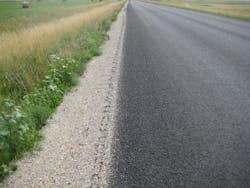N.D. rocky road gets a stabilizing hand
Bowman County, N.D., Highway Superintendent Neil Hofland was facing 6 miles of high-maintenance aggregate for 94th Street SW, which leads to a saltwater disposal well and receives 100-200 average daily traffic. The section was bladed weekly because of unraveling and washboarding, and soft spots had to be reworked every two weeks. This road also was extremely dusty, and local ranchers reported several instances of “dust pneumonia” showing up in their cattle.
“Something needed to be done or we would continue to lose a half to one inch of gravel per year and still have the dust problem,” said Hofland. “The county wanted to retain the gravel that was being added, as the good gravel is getting harder to find and is more costly to buy.”
“We looked at two options: utilize concrete in the subgrade and also in the top 3-4 in. of the aggregate; or utilize Base One and put a double Armor Coat over the stabilized base,” continued Hofland.
“We decided to use Team Laboratory Chemical Corp.’s Base One based on our past success with the product, surrounding counties’ success with a double chip-seal surface, cost involved, and the work could be done by county forces,” Hofland stated. “The subgrade was sandy and had sections of gumbo throughout the project. The east 3 miles were reconstructed in 2012 and 3 in. of new gravel was added. The 3 in. of material was then stabilized with Base One in 2013. The west 3 miles had numerous soft spots dug out and 6 in. of new gravel added in 2013, stabilizing all 6 in. with [the base stabilizer]. The addition of double chip seal was done by shooting the stabilized surface with a light coating of water, then adding emulsion oil (Pass CR) and no prime. We immediately applied 3/4-in. chips, compacted and let it set for nine days. Following the nine days, we applied an HFMS-2 and added 3/8-in. chips. We waited one day, swept the loose chips and fogged the surface with CSS-1H.”
Hofland concluded, “The results have been outstanding. Last winter was a tough winter with above-average snowfall, and the road has shown very minimal cracking. We selected this option primarily because in past years the road would eventually reveal soft spots without the use of a stabilizer, and we wanted to provide the community with a hard, smooth driving surface for many years to come.”
